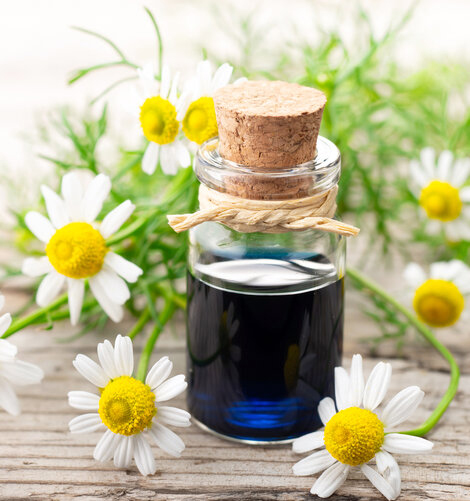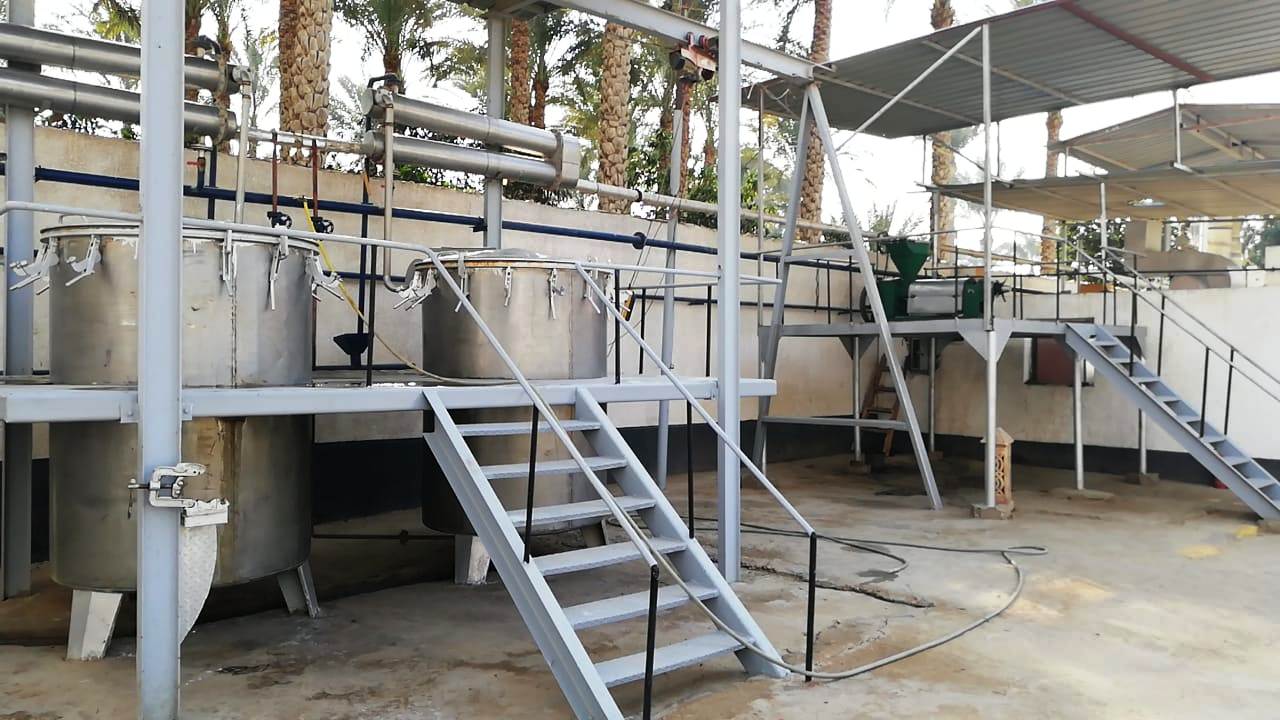German Chamomile Blue Matricaria chamomilla Essential Oil
Login to view prices
Common name: German Chamomile
Latin name: Matricaria recutita L..
Family: Asteraceae (Compositae)
Other names: Engl.: German chamomile, scented mayweed, chamomile, false chamomile, German tea chamomile, Hungarian chamomile, sweet chamomile. Deu.: Echte Kamille, Kamille, Frauenblume, Johannisköpfchen, Mägdeblume, Ramerian. Suom.: kamomillasaunio. Sven.: kamomill, sötblomster, äkta kamomill. Fran.: camomille. Bot. syn.: Chamomilla officinalis Koch, Chamomilla recutita (L.) Rauschert, Chrysanthemum chamomilla Bernh., Matricaria chamomilla auct..
This plant was formerly classified as Matricaria chamomilla L.
Botanical Origin:
Common name: German Chamomile
Latin name: Matricaria recutita L..
Family: Asteraceae (Compositae)
Other names: Engl.: German chamomile, scented mayweed, chamomile, false chamomile, German tea chamomile, Hungarian chamomile, sweet chamomile. Deu.: Echte Kamille, Kamille, Frauenblume, Johannisköpfchen, Mägdeblume, Ramerian. Suom.: kamomillasaunio. Sven.: kamomill, sötblomster, äkta kamomill. Fran.: camomille. Bot. syn.: Chamomilla officinalis Koch, Chamomilla recutita (L.) Rauschert, Chrysanthemum chamomilla Bernh., Matricaria chamomilla auct..
This plant was formerly classified as Matricaria chamomilla L.
Description:
Matricaria recutita L. possesses a many-branched erect growing stem, 1 or 2 ft. high, bearing very green, smooth and alternate leaves. The flower heads appear singly at the ends of stems and branches. The flowers are smaller than those of Anthemis nobilis L., the so called Roman chamomile, and are yellow disc white ray flowers.
After drying, the flower-heads are of a dull yellow or yellowish-white color, about 10 mm. (2/5 in.) broad, surrounded by a flattish, imbricated involucre; this involucre is composed of oblong scales, having a membranous, translucent margin; the receptacle is conical, internally hollow, and bears a single row of about fifteen short, toothed, reflexed ray-florets, and numerous tubular yellow disk-florets, without pappus; disagreeably aromatic; taste bitterish, aromatic.
Range & Habitat:
German chamomile, Matricaria recutita L. is native to Europe and western Asia and naturalized in North America, and is cultivated in Germany, Hungary, Russia and several other European countries.
The plant thrives in moderately heavy soil, rich in humus and rather moist. It can withstand considerable cold. In Hungary, it also grows abundantly in great patches in the clayey lime soil of the plains, where the depleted and almost barren condition of the earth offers little support for other flora.
The reported life zone for the chamomiles is 7 to 26 ºC with an annual precipitation of 0.4 to 1.4 meters and a soil pH 4.8 to 8.3. Seeded or transplanted into the field for cultivation, Cultivated from seed, German chamomile grows in poor, clay soils. The short, two-month growing season of German chamomile allows it to be interplanted with other biennial herbs or planted as a nearly or late crop.
Planting & Cultivation:
Chamomile blooms from the end of April to the end of May, about eight weeks after the seed is sown. A crop may thus be raised from seeds grown early in the spring, or from seeds planted later, after early vegetable crops. Seed may be sown in drills and barely covered, or it may be broadcast, since the plant soon occupy the entire ground, and exclude weeds.
Harvesting and Preparing for the Market:
The chamomile grown on farmland is gathered by hand, which permits removal of the flowers without the stem. In other sections, however, it must be collected by means of flower scoops or strippers. When using these implements, the harvesters must gather the flowers as carefully and with as little stem material and extraneous matter as possible.
A single worker with a “flower comb” can collect from 60 to 100 kg of fresh flowers per day; by hand he can gather only 8 to 10 kg.
The harvested flowers are sifted in a suspended sieve (mesh diameter, 7-11 mm), to separate the flower heads from the flowers with attached stems, and from climbing bits of weed or grass. Thus sifted, the flowers are spread out on the floor or on sheets, in thin layers, to dry. Artificial dryers may also be employed. The delicate material must not be turned while drying, since it is easily damaged.
Five kg of fresh flowers give 1 kg of air-dried flowers. These are sifted once more, and packed into boxes or bales for shipment. If packed in bags, the flowers are likely to be damaged by handling.
Yield of flowers per Acre:
One acre yields about 400 to 600 lb of dried flowers under favorable conditions.
Chamomile flowers exported from Hungary was marketed in six grades:
- The “Extra” grade, assorted by hand, was of beautiful appearance and usually three times higher in price than other grades.
- Type V, the so-called “bath chamomile”, consisted of flowers with attached stems as they remained in the sieve after sifting of the dried material. This quality was used in pharmacy, chiefly for external application.
- Type VI, the so-called “ chamomile dust” consisted of sifted-out dust.
Method of Extraction:
By Steam Distillation.
High-grade chamomile flowers are much too costly to use for essential oil production. For this purpose, therefore, only the lower grades, including flowers with stalks (“bath chamomile”), siftings, and dust are employed in Hungary and Germany.
Dust alone, however, cannot easily be distilled with direct steam, because it has a tendency to “bake” in the retort and to form lumps, through which the steam cannot penetrate. To prevent this, dust is first thoroughly mixed with an inert material, such as straw, or, still better, with flowers and stalks.
Because oil of chamomile consists chiefly of high boiling constituents, including paraffins, steam of relatively high pressure (7 atm/cm2, in the steam generator) is applied.
Distillation of one charge requires from 7 to 13 hr. chamomile oil may separate crystals even at +15ºC, and has a tendency to form a deposit on the cool walls inside of the condenser tubes. It is therefore, necessary to stop the flow of the cooling water from time to time, until the temperature of the condenser rises sufficiently for the deposit to reliquify and flow off. Great care must be employed in doing this.
Certain constituents of the oil are soluble in large quantities of warm water; moreover the oil has a high specific gravity and tends to flow off with the distillation water in the form of milky emulsion. For these reasons the distillation water must be redistilled (cohobated); by this means as much as 30 % of the total oil distilled over may be recovered.
Yield of oil:
Determining the volatile oil content of 84 chamomile samples originating from 10 different regions, yields ranging from 0.25 to 1.35%, the average being 0.48% were obtained.
Major suppliers to the world market for German chamomile include Argentina, Egypt, the Czech Republic, Slovakia, Germany, Hungary and Poland.
Although there are a number of countries producing the essential, only four can be taken seriously at this time: Egypt (1000 kg), Hungary (1000 kg), Bulgaria (700 kg) and Slovakia (100 kg). Long term, a virgin plantation in Argentina is showing promise and quality is comparable to the above major outlets.
In Europe the herb is a summer crop, while in Egypt it is a winter crop used as a fill-in between cereal crops. The flowers are usually graded for export with the rejects making up a large proportion of the essential oil production. Maximum exposure to sunlight improves essential oil quality as well as chamazulene content
[1] Source: Simon, J.E., A.F. Chadwick and L.E. Craker. 1984. Herbs: An Indexed Bibliography. 1971-1980. The Scientific Literatureon Selected Herbs, and Aromatic and Medicinal Plants of the TemperateZone. Archon Books, 770 pp., Hamden, CT. The Essential Oils. By Ernest Guenther. 1950
Notes:
- The oil derived from Matricaria recutita is too dark in color to permit the determination of the optical rotation or refractive index.
- Under the influence of light and air the deep blue color of the oil gradually changes to green, and finally to brown.
- Some oils are quite viscous even at 15°C and at that temperature crystals start to separate; the specific gravity of such oils has to be determined in their superfused state.
- The content of chamazulene in the various chamomile oils depends upon the origin and the age of the flower material; it decreases during storage of the flowers. The plant itself doesn’t contain the azulene in the free form but as a precursor which decomposes on heating, or in an acid medium, yielding the azulene. Thus chamazulene present in the essential oil is formed during distillation of the plant material. Once distilled over, it will both alter the color and odor profile of the resultant oil and the longer the oil is distilled, the brighter the blue the hue and the more diffusive the aroma
- The oil is opaque in bulk, but in layers transparent.
Adulteration & its Detection:
The oil is subject to much adulteration, especially with:
| Adulterant | Appropriate method for detection | Notes |
| “The similar flower-heads of Anthemis arvensis L., and Maruta Cotula De Candolle (Fam. Compositae), have conical, solid, and chaffy receptacles.” U. S. VIII.
In addition to the above it is sometimes admixed with the flower-heads of other European species of Anthemis. Sometimes the flower-heads of the common daisy (Chrysanthemum leucanthemum L.) as well as other species of Chrysanthemum are present in the drug of commerce |
Matricaria is officially described as follows: “Flower-heads composed of a few white ray-florets and numerous yellow disk-florets on conical, more or less hollow receptacles, the latter being from 3 to 10 mm. in breadth; disk-flowers tubular, perfect, and without a pappus; ray-flowers from 10 to 20, pistillate, corolla white, 3-toothed and 4-veined, usually reflexed; involucre hemispherical, composed of from 20 to 30 imbricated, oblanceolate, and pubescent scales; peduncles light green to brownish-green, longitudinally furrowed, more or less twisted and attaining a length of 2.5 cm.; achenes somewhat obovoid and faintly 3-to 5-ribbed; pappus none, or only a slight membranous crown; odor pleasant, aromatic; taste aromatic and bitter. Matricaria yields not more than 13 per cent. of ash.” U. S. |
Additional information
| Weight | N/A |
|---|---|
| Dimensions | N/A |
| Oil Purity | 100% Natural & Pure without any chemical, flavor, food additive or carrier. |
| Ship from | Egypt |
| Country of Origin | Egypt |
| Cultivation Type | Organic Certified, Organic not Certified, Conventional |
| Oil Bulk Packaging | 25 kg HDPE Plastic Jerrycan, 50 kg HDPE Plastic drum |
| HS Code | 33012990 |
| CAS Number | 8015-92-7 |
| Oil Documentation Available | Allergen Free Certificate, Bovine Spongiform Encephalophathy (BSE) Certificate, Certificate of Analysis (COA), GMO Certificate, GRAS Status Statement, Halal Certificate, Herbal Origin Statement, KOSHER Certificate, Manufacturing Flow Chart, Material Safety Data Sheet (MSDS), Organic Certificate, Pesticide Residual Certificate, Researches & Studies, Technical Data Sheet (TDS), WADA Prohibited list Statement |
-
Login to view prices
Jasmine Infused Oil (Natural Jasmine oil or flowers infused in Carrier Oil)
Login to view prices Read more -
Login to view prices
Rose Infused Oil (Natural Rose oil or flowers infused in Carrier Oil)
Login to view prices Read more -
Login to view prices
-
Login to view prices







